RDN/Trojan/Hacking File Detected Scam
AdwareAlso Known As: "RDN/Trojan/Hacking file detected" virus
Get free scan and check if your device is infected.
Remove it nowTo use full-featured product, you have to purchase a license for Combo Cleaner. Seven days free trial available. Combo Cleaner is owned and operated by RCS LT, the parent company of PCRisk.com.
What is RDN/Trojan/Hacking File Detected?
Similar to Possible Suspicious Activity, Hard Drive Is Not Accepted, Windows 10 Pro Update Failed, and many others, "RDN/Trojan/Hacking File Detected" is a fake error message displayed by malicious websites. Users often visit these websites inadvertently - they are redirected by various potentially unwanted programs (PUPs).
Research shows that these programs infiltrate systems without permission or trick users to install by falsely claiming to provide "useful features". As well as causing redirects, PUPs deliver malvertising ads, diminish system performance, and record private information.
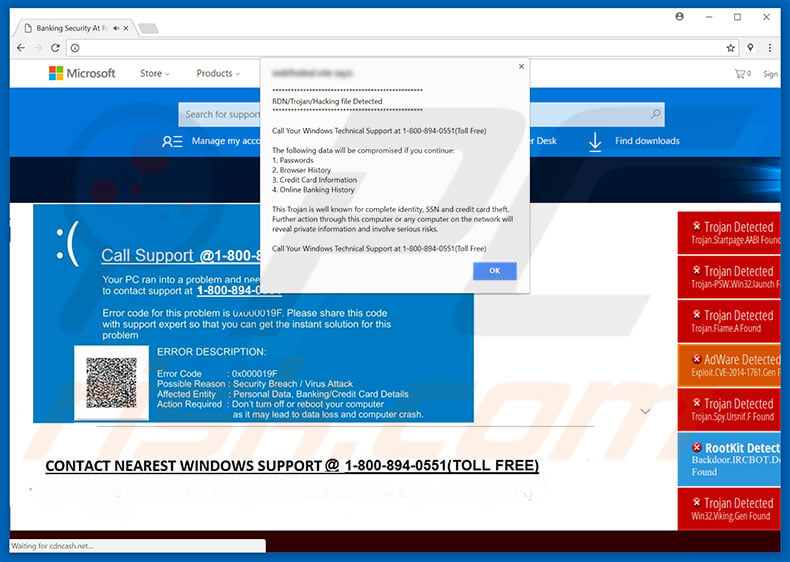
"RDN/Trojan/Hacking File Detected" states that the system has been infected with an error known to gather various personal information (for example, logins/passwords, credit card information, browsing history, etc.) The message encourages users to eliminate this malware by contacting "Windows Technical Support" via a telephone number ("1-800-894-0551") provided.
Victims then supposedly receive help in resolving this issue. Be aware, however, that "RDN/Trojan/Hacking File Detected" is fake and has nothing to do with Microsoft (the Windows Operating System developers).
Cyber criminals generate revenue by claiming to be certified technicians and offering paid technical support that is not required (the aforementioned malware simply does not exist). In addition, these people often demand remote access to users' computers. Once connected, they stealthily modify computer settings (for example, users' passwords) or install malware.
These criminals falsely claim to "detect" various system errors/infections and offer further services for additional fees. Never call the telephone number. The "RDN/Trojan/Hacking File Detected" error can be removed by closing the web browser or restarting the computer.
As mentioned above, PUPs often deliver various ads (pop-ups, coupons, banners, etc.) - these are displayed using various tools that enable placement of third party graphical content on any site. They conceal underlying content, thereby significantly diminishing the browsing experience. In addition, they might lead to malicious websites and run scripts that infect the computer.
Therefore, even accidental clicks can result in high-risk computer infections. Some PUPs run unwanted background processes (such as mining of cryptocurrency). By misusing computer resources, PUPs significantly diminish computer performance. They are also known to record user-system information relating to browsing activity.
The data is later sold to third parties for marketing purposes and to generate revenue. For these reasons, we strongly advise you to uninstall all potentially unwanted programs immediately.
| Name | "RDN/Trojan/Hacking file detected" virus |
| Threat Type | Adware, Unwanted ads, Pop-up Virus |
| Symptoms | Seeing advertisements not originating from the sites you are browsing. Intrusive pop-up ads. Decreased Internet browsing speed. |
| Distribution methods | Deceptive pop-up ads, free software installers (bundling), fake flash player installers. |
| Damage | Decreased computer performance, browser tracking - privacy issues, possible additional malware infections. |
| Malware Removal (Windows) |
To eliminate possible malware infections, scan your computer with legitimate antivirus software. Our security researchers recommend using Combo Cleaner. Download Combo CleanerTo use full-featured product, you have to purchase a license for Combo Cleaner. 7 days free trial available. Combo Cleaner is owned and operated by RCS LT, the parent company of PCRisk.com. |
There are hundreds of potentially unwanted programs that share many similarities. By offering various "useful features", they attempt to give the impression of legitimacy, however, the actual purpose of these applications is to generate revenue for the developers. Most PUPs are useless for regular users - only a fraction provide the features promised.
They merely promote malicious websites (by causing unwanted redirects), deliver intrusive advertisements (via the "Pay Per Click" advertising model), diminish computer performance, and continually record user-system information.
How did adware install on my computer?
Some PUPs have official download/promotion websites, however, they are also proliferated using a deceptive marketing method called "bundling", and via the aforementioned ads. Bundling is stealth installation of third party programs together with regular software/apps. Many users rush the download/installation processes and skip steps.
Therefore, criminals conceal "bundled" applications (usually within the "Custom/Advanced" settings). Skipping steps (and clicking ads) exposes systems to risk of various infections and compromises users' privacy.
How to avoid installation of potentially unwanted applications?
The main reasons for computer infections are careless behavior and lack of knowledge. Therefore, be very cautious when browsing the Internet and especially when downloading/installing software. 'Malvertising' ads usually appear legitimate, but often lead to survey, pornography, adult dating, gambling, and other suspicious websites.
If you are redirected to this type of site, immediately remove all suspicious applications and browser extensions. Furthermore, select the "Custom/Advanced" settings, carefully analyze each download/installation step, and cancel all additionally-included programs.
Third party download/installation tools commonly bundle PUPs. Therefore, do not use them. We strongly recommend that you download your software from official sources only using a direct download URL. The key to computer safety is caution.
The appearance of "RDN/Trojan/Hacking File Detected" scam pop-up (GIF):
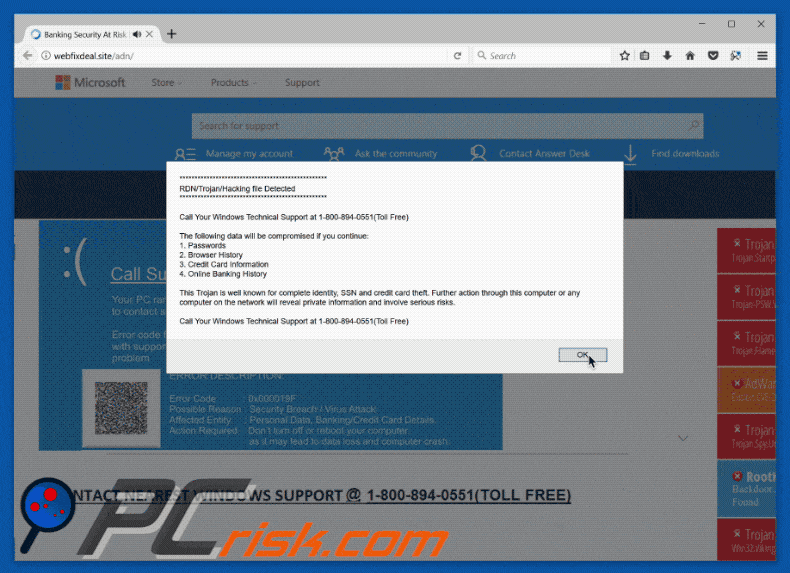
Text presented in this scam pop-up:
RDN/Trojan/Hacking file detected
Call Your Windows Technical Support at 1-800-894-0551 (Toll Free)
The following data will be compromised if you continue:
1. Passwords
2. Browser History
3. Credit Card Information
4. Online Banking HistoryThis Trojan is well known for complete identity, SSN and credit card theft. Further action through this computer or any computer on the network will reveal private information and involve serious risk.
Call Your Windows Technical Support at 1-800-894-0551 (Toll Free)
Call Support @ 1-800-894-0551 (TOLL FREE)
Your PC ran into a problem and needs urgent attention. You need to contact support at 1-800-894-0551Error code for this problem is 0x000019F. Please share this code with support expert so that you can get the instant solution for this problem.
ERROR DESCRIPTION:
Error Code: 0x000019F
Position Reason: Security Breach/Virus Attack
Affected Entity: Personal Data, Banking/Credit Card Deatails
Action Required: Don’t turn off or reboot your computer as it may lead to data loss and computer crash.CONTACT NEAREST WINDOWS SUPPORT @ 1-800-894-0551 (TOLL FREE)
Trojan Detected
Trojan.Startpage.AABI FoundTrojan Detected
Trojan-PSW.Win32.Launch FoundTrojan Detected
Trojan.Flame.A FoundAdWare Detected
Expoit.CVE-2014-1761.Gen FoundTrojan Detected
Trojan.Spy.Ursnif.F FoundRootKit Detected
Backdoor.IRCBOT.Dorbot.A FoundTrojan Detected
Win32.Viking.Gen Found
Instant automatic malware removal:
Manual threat removal might be a lengthy and complicated process that requires advanced IT skills. Combo Cleaner is a professional automatic malware removal tool that is recommended to get rid of malware. Download it by clicking the button below:
DOWNLOAD Combo CleanerBy downloading any software listed on this website you agree to our Privacy Policy and Terms of Use. To use full-featured product, you have to purchase a license for Combo Cleaner. 7 days free trial available. Combo Cleaner is owned and operated by RCS LT, the parent company of PCRisk.com.
Quick menu:
- What is RDN/Trojan/Hacking File Detected?
- STEP 1. Uninstall deceptive applications using Control Panel.
- STEP 2. Remove adware from Internet Explorer.
- STEP 3. Remove rogue extensions from Google Chrome.
- STEP 4. Remove potentially unwanted plug-ins from Mozilla Firefox.
- STEP 5. Remove rogue extensions from Safari.
- STEP 6. Remove rogue plug-ins from Microsoft Edge.
Adware removal:
Windows 11 users:

Right-click on the Start icon, select Apps and Features. In the opened window search for the application you want to uninstall, after locating it, click on the three vertical dots and select Uninstall.
Windows 10 users:

Right-click in the lower left corner of the screen, in the Quick Access Menu select Control Panel. In the opened window choose Programs and Features.
Windows 7 users:

Click Start (Windows Logo at the bottom left corner of your desktop), choose Control Panel. Locate Programs and click Uninstall a program.
macOS (OSX) users:

Click Finder, in the opened screen select Applications. Drag the app from the Applications folder to the Trash (located in your Dock), then right click the Trash icon and select Empty Trash.
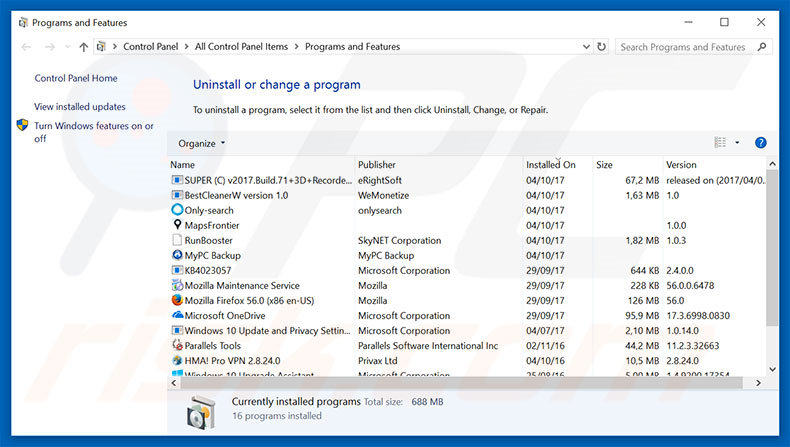
In the uninstall programs window, look for any suspicious/recently-installed applications, select these entries and click "Uninstall" or "Remove".
After uninstalling the potentially unwanted program, scan your computer for any remaining unwanted components or possible malware infections. To scan your computer, use recommended malware removal software.
DOWNLOAD remover for malware infections
Combo Cleaner checks if your computer is infected with malware. To use full-featured product, you have to purchase a license for Combo Cleaner. 7 days free trial available. Combo Cleaner is owned and operated by RCS LT, the parent company of PCRisk.com.
Remove adware from Internet browsers:
Video showing how to remove potentially unwanted browser add-ons:
 Remove malicious add-ons from Internet Explorer:
Remove malicious add-ons from Internet Explorer:
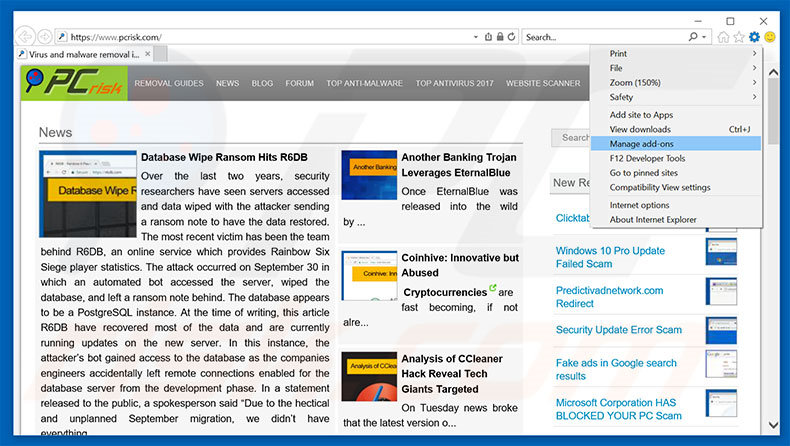
Click the "gear" icon ![]() (at the top right corner of Internet Explorer), select "Manage Add-ons". Look for any recently-installed suspicious browser extensions, select these entries and click "Remove".
(at the top right corner of Internet Explorer), select "Manage Add-ons". Look for any recently-installed suspicious browser extensions, select these entries and click "Remove".
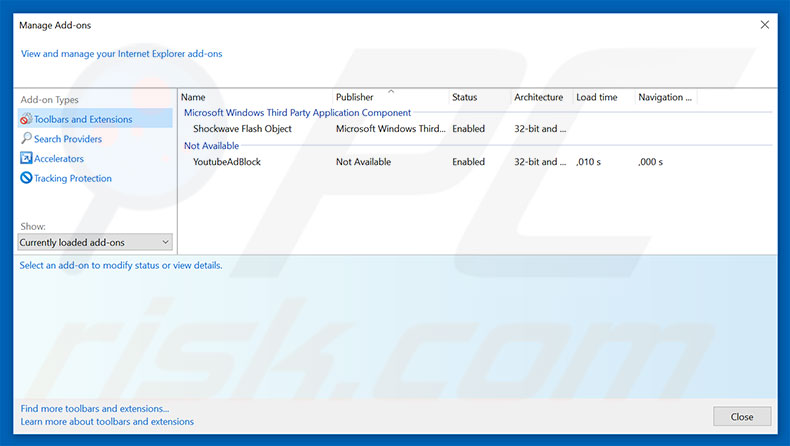
Optional method:
If you continue to have problems with removal of the "rdn/trojan/hacking file detected" virus, reset your Internet Explorer settings to default.
Windows XP users: Click Start, click Run, in the opened window type inetcpl.cpl In the opened window click the Advanced tab, then click Reset.

Windows Vista and Windows 7 users: Click the Windows logo, in the start search box type inetcpl.cpl and click enter. In the opened window click the Advanced tab, then click Reset.

Windows 8 users: Open Internet Explorer and click the gear icon. Select Internet Options.

In the opened window, select the Advanced tab.

Click the Reset button.

Confirm that you wish to reset Internet Explorer settings to default by clicking the Reset button.

 Remove malicious extensions from Google Chrome:
Remove malicious extensions from Google Chrome:
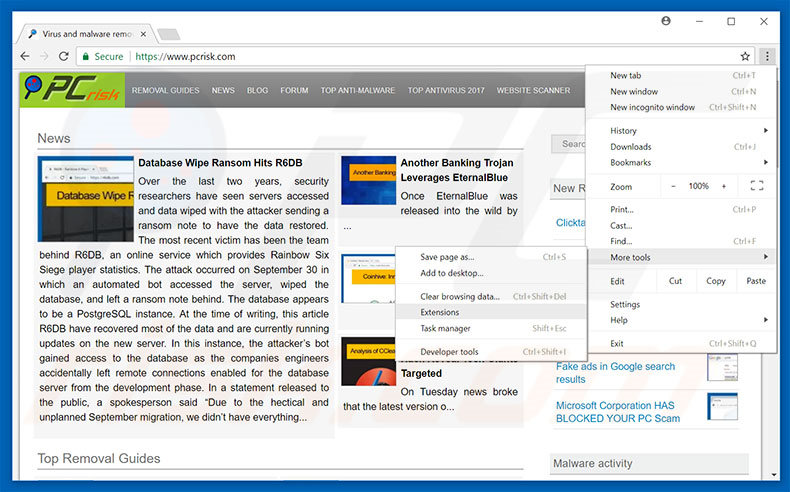
Click the Chrome menu icon ![]() (at the top right corner of Google Chrome), select "More tools" and click "Extensions". Locate all recently-installed suspicious browser add-ons, select these entries and click the trash can icon.
(at the top right corner of Google Chrome), select "More tools" and click "Extensions". Locate all recently-installed suspicious browser add-ons, select these entries and click the trash can icon.
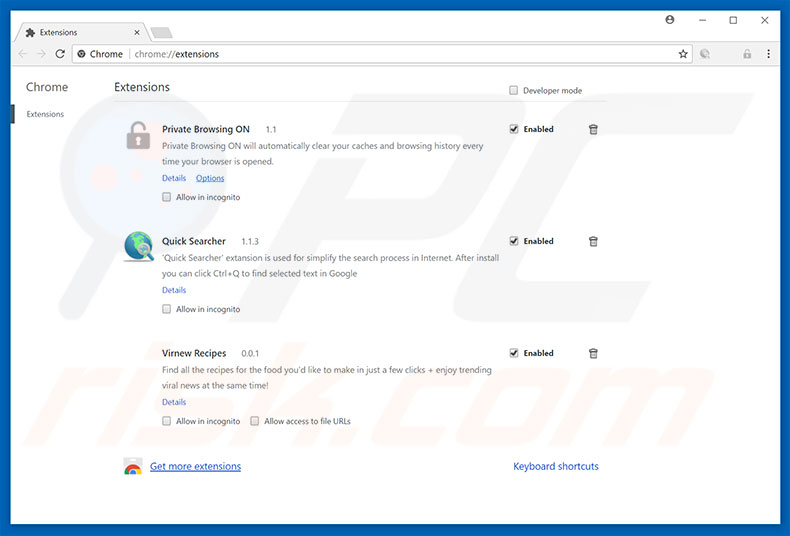
Optional method:
If you continue to have problems with removal of the "rdn/trojan/hacking file detected" virus, reset your Google Chrome browser settings. Click the Chrome menu icon ![]() (at the top right corner of Google Chrome) and select Settings. Scroll down to the bottom of the screen. Click the Advanced… link.
(at the top right corner of Google Chrome) and select Settings. Scroll down to the bottom of the screen. Click the Advanced… link.

After scrolling to the bottom of the screen, click the Reset (Restore settings to their original defaults) button.

In the opened window, confirm that you wish to reset Google Chrome settings to default by clicking the Reset button.

 Remove malicious plug-ins from Mozilla Firefox:
Remove malicious plug-ins from Mozilla Firefox:
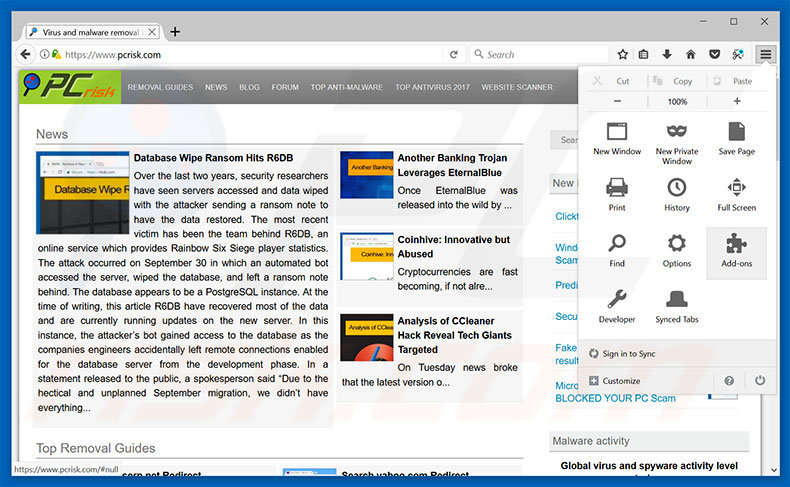
Click the Firefox menu ![]() (at the top right corner of the main window), select "Add-ons". Click "Extensions", in the opened window, remove all recently-installed suspicious browser plug-ins.
(at the top right corner of the main window), select "Add-ons". Click "Extensions", in the opened window, remove all recently-installed suspicious browser plug-ins.
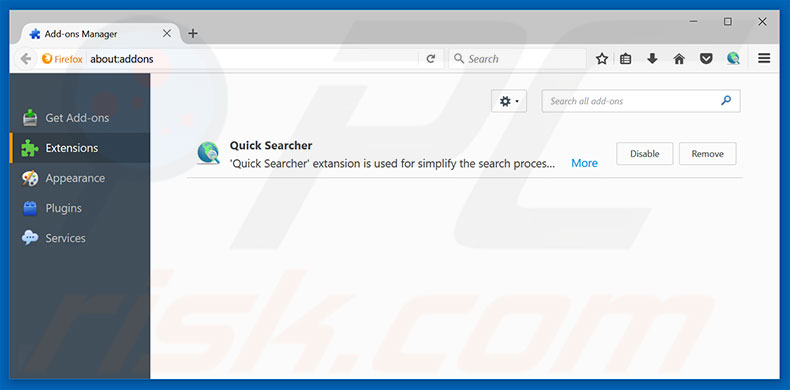
Optional method:
Computer users who have problems with "rdn/trojan/hacking file detected" virus removal can reset their Mozilla Firefox settings.
Open Mozilla Firefox, at the top right corner of the main window, click the Firefox menu, ![]() in the opened menu, click Help.
in the opened menu, click Help.

Select Troubleshooting Information.

In the opened window, click the Refresh Firefox button.

In the opened window, confirm that you wish to reset Mozilla Firefox settings to default by clicking the Refresh Firefox button.

 Remove malicious extensions from Safari:
Remove malicious extensions from Safari:

Make sure your Safari browser is active, click Safari menu, and select Preferences....

In the opened window click Extensions, locate any recently installed suspicious extension, select it and click Uninstall.
Optional method:
Make sure your Safari browser is active and click on Safari menu. From the drop down menu select Clear History and Website Data...

In the opened window select all history and click the Clear History button.

 Remove malicious extensions from Microsoft Edge:
Remove malicious extensions from Microsoft Edge:

Click the Edge menu icon ![]() (at the upper-right corner of Microsoft Edge), select "Extensions". Locate all recently-installed suspicious browser add-ons and click "Remove" below their names.
(at the upper-right corner of Microsoft Edge), select "Extensions". Locate all recently-installed suspicious browser add-ons and click "Remove" below their names.

Optional method:
If you continue to have problems with removal of the "rdn/trojan/hacking file detected" virus, reset your Microsoft Edge browser settings. Click the Edge menu icon ![]() (at the top right corner of Microsoft Edge) and select Settings.
(at the top right corner of Microsoft Edge) and select Settings.

In the opened settings menu select Reset settings.

Select Restore settings to their default values. In the opened window, confirm that you wish to reset Microsoft Edge settings to default by clicking the Reset button.

- If this did not help, follow these alternative instructions explaining how to reset the Microsoft Edge browser.
Summary:
 Commonly, adware or potentially unwanted applications infiltrate Internet browsers through free software downloads. Note that the safest source for downloading free software is via developers' websites only. To avoid installation of adware, be very attentive when downloading and installing free software. When installing previously-downloaded free programs, choose the custom or advanced installation options – this step will reveal any potentially unwanted applications listed for installation together with your chosen free program.
Commonly, adware or potentially unwanted applications infiltrate Internet browsers through free software downloads. Note that the safest source for downloading free software is via developers' websites only. To avoid installation of adware, be very attentive when downloading and installing free software. When installing previously-downloaded free programs, choose the custom or advanced installation options – this step will reveal any potentially unwanted applications listed for installation together with your chosen free program.
Post a comment:
If you have additional information on "rdn/trojan/hacking file detected" virus or it's removal please share your knowledge in the comments section below.
Share:

Tomas Meskauskas
Expert security researcher, professional malware analyst
I am passionate about computer security and technology. I have an experience of over 10 years working in various companies related to computer technical issue solving and Internet security. I have been working as an author and editor for pcrisk.com since 2010. Follow me on Twitter and LinkedIn to stay informed about the latest online security threats.
PCrisk security portal is brought by a company RCS LT.
Joined forces of security researchers help educate computer users about the latest online security threats. More information about the company RCS LT.
Our malware removal guides are free. However, if you want to support us you can send us a donation.
DonatePCrisk security portal is brought by a company RCS LT.
Joined forces of security researchers help educate computer users about the latest online security threats. More information about the company RCS LT.
Our malware removal guides are free. However, if you want to support us you can send us a donation.
Donate
▼ Show Discussion